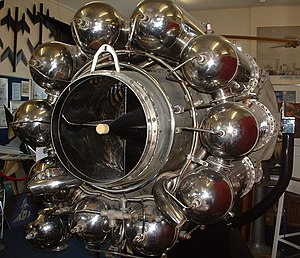Power Jets W.2
| W.2 | |
|---|---|
 |
|
| Preserved Power Jets W.2/700 at the Farnborough Air Sciences Trust (rear view). | |
| Type | Turbojet |
| Manufacturer | Rover Car Company |
| First run | c.1941 |
| Major applications |
Gloster E.28/39 Gloster F.9/40 |
| Developed from | Power Jets W.1 |
| Developed into | (W.2B-Rover B.23) Rolls-Royce Welland (W.2B/500-Rover B.26) Rolls-Royce Derwent |
The Power Jets W.2 was a British turbojet engine designed by Frank Whittle and Power Jets (Research and Development) Ltd. Like the earlier Power Jets W.1, the "trombone" configuration featured a simple double-sided centrifugal compressor, reverse-flow combustion chambers and an air-cooled axial-flow turbine section.
In 1940 the Air Ministry placed a contract with the Gloster Aircraft Company for prototypes of a new twin-engined jet fighter aircraft to the requirement of F.9/40, this aircraft became the Gloster Meteor. At the same time Power Jets was authorised to design a new engine that was intended to power the same aircraft. The W.2 was built under contract by the Rover Car Company in the early 1940s. Relations between Power Jets and Rover were somewhat strained and development of the W.2 was very slow. However, in late 1942, Rover agreed to exchange their jet engine factory at Barnoldswick, Lancashire for the Rolls-Royce Meteor tank engine factory in Nottingham, with no money changing hands. At the behest of the UK government, Rolls-Royce thereupon assumed control of the W.2 project, with Frank Whittle and his small team at Power Jets acting in an advisory capacity. Together, they ironed out the problems with the W.2 and finally put the engine into mass production as the 1,600 pounds-force (7.1 kN) thrust Rolls-Royce Welland. These engines were installed in the Gloster Meteor F Mk1 and early F Mk3's and entered service in 1944.
After initial suggestions in 1939 by the Engine Department of the Royal Aircraft Establishment (RAE), the latter's Pyestock Section experimented with the technique of injecting fuel into the engine's exhaust nozzle, later known as reheat, and this technique was further refined after Power Jets and the personnel from Pyestock had been amalgamated. Reheat was later fight trialled in the W.2/700 engines in a Meteor I. The technique increased the Meteor's speed by 30-40mph.
...
Wikipedia
